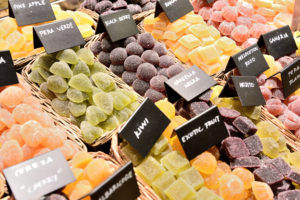** District Court Rejects Slack Fill Defendant’s Claims That Package Size is Not Commercial Speech **
By: Brent E. Johnson .

We’ve blogged about the rise in slack-fill consumer class actions and, specifically, the numerous actions brought against McCormick and Company for allegedly under filling its red, white and blue pepper tins. These lawsuits were consolidated and transferred to the United States District Court for the District of Columbia in December 2015. Curiously, one individual action initially brought in Minnesota federal court was allowed to come along for the ride – and it was this single-plaintiff lawsuit that started the avalanche of consumer actions against McCormick. “Who was the plaintiff?” you ask. McCormick’s competitor, Watkins, Inc., claiming a Lanham Act violation for the alleged slack-fill in McCormick’s pepper tins. Watkins filed its complaint on June 9, 2015, and a week later, the consumer class actions started cascading downhill.
Lanham Act cases are very different beasts from consumer class actions even though they both focus on alleged misrepresentations made to consumers. In a Lanham Act lawsuit, the competitor is trying to collect lost profits (or disgorgement of the defendant’s profits) due to “a false or misleading representation of fact” in “commercial advertising or promotion.” 15 U.S.C. § 1125(a)(1). In a consumer class action, on the other hand, the class representative is trying to recover for the class either the entire purchase price of the product or the “price premium” class members paid for it based on the misrepresentation under state statutes and common law.
Slack-fill cases, of course, do not involve words – rather, they focus on the size of the package. As the FDA elucidates: “A container that does not allow the consumer to fully view its contents shall be considered to be filled as to be misleading if it contains nonfunctional slack-fill. Slack-fill is the difference between the actual capacity of a container and the volume of product contained therein. Nonfunctional slack-fill is the empty space in a package that is filled to less than its capacity.” 21 C.F.R. § 100.100(a). In McCormick’s case, it sought dismissal of Watkin’s complaint on the theory (among others) that a container’s size is not “commercial advertising and promotion” because no words are involved”, citing Farah v. Esquire Magazine, 736 F.3d 528, 541 (D.C. Cir. 2013), where the court concluded that the Lanham Act only applies to “commercial speech.”
In this case of first impression – there are no other reported cases of one competitor suing another over slack-fill – Judge Ellen Segal Huvelle was not buying what McCormick was selling: “McCormick argues that size of its pepper tins is not commercial speech, but it is difficult to understand how the size of a package or container could possibly not be considered a form of ‘advertising or promotion.’ The size of a package signals to the consumer vital information about a product and is as influential in affecting a customer’s choices as an explicit message on its surface.” Memorandum Opinion, MDL Docket No. 2665, Misc. No. 15-1825 (ESH) (October 17, 2016). The court analogized package size to other non-verbal advertising, such as images appearing on a product’s container. In sum, like Depeche Mode, Judge Huvelle concluded that “words are very unnecessary” to make out a Lanham Act claim.

 We have blogged in the past about some of the “usual suspects” in the consumer class action line-up – particularly for food, beverage, cosmetics and related industries – for example, the
We have blogged in the past about some of the “usual suspects” in the consumer class action line-up – particularly for food, beverage, cosmetics and related industries – for example, the  Bucking the popular notion that the legal system protects its own – a recent putative class action in Illinois bought by and for a class of lawyers – failed. Vrdolyak v. Avvo, Inc., No. 16 C 2833, 2016 WL 4765716, at *1 (N.D. Ill. Sept. 12, 2016). The defendant in the lawsuit,
Bucking the popular notion that the legal system protects its own – a recent putative class action in Illinois bought by and for a class of lawyers – failed. Vrdolyak v. Avvo, Inc., No. 16 C 2833, 2016 WL 4765716, at *1 (N.D. Ill. Sept. 12, 2016). The defendant in the lawsuit, 
